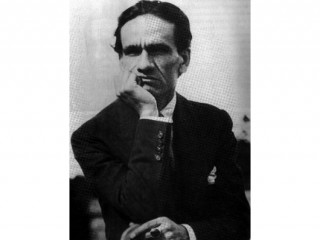
Cesar Vallejo biography
Date of birth : 1892-03-16
Date of death : 1938-04-15
Birthplace : Santiago de Chuco, Peru
Nationality : Peruvian
Category : Famous Figures
Last modified : 2011-02-01
Credited as : Poet, Poemas humanas ,
Cesar Abraham Vallejo, frequently characterized as one of Peru's best 20th-century poets, is chiefly distinguished by his use of regional themes and characters.
Cesar Vallejo was the eleventh and last child of a lower-middle-class mestizo family of north-central Peru. He was born in the mountain community of Santiago de Chuco on March 16, 1892, and received his elementary education there. He then managed to attend the regional university at Trujillo and obtained his degree in 1915. He remained in Trujillo until 1918, employed in the local schools.
Vallejo had, by the beginning of his university studies, begun to write, finding an outlet for his poems in the local newspapers; and then, with a more established reputation, he was able to find acceptance in journals that had a wider circulation. As a writer of promise, he became a member of a local literary-intellectual circle. Although its members were most interested in literary affairs, meeting twice weekly to read their own poetry or to study the writings of such currently important authors as Ruben Dario, Amado Nervo, Walt Whitman, and Maurice Maeterlinck, they also were deeply involved in sociopolitical schemes for reform. These were certainly the interests of such a member as the political philosopher Victor Raúl Haya de la Torre, the founder of APRA (American Popular Revolutionary Alliance). Thus, even at that early point, Vallejo's interests were in social reform, as well as in poetic expression.
In 1918, the year Vallejo left Trujillo for the broader horizons of Lima, he published his first collection of poems, Los heraldos negros (The Black Heralds). The themes were of the daily lives of the Peruvians of his region and class, their joys, their loves, their sufferings at the hands of a fate they could neither influence nor control. But if the themes were local and national, the poems were more cosmopolitan, showing so much the influence of the modernists and others that one critic said that the poems were, like the author, "mestizo, " to show their mixed European-Amerindian character.
During 1919 Vallejo was associated with the short-lived but significant review Nuestra epoca. Although the magazine was a financial failure, its editors had, by the end of 1919, attracted so much attention because of their reformist zeal that most of them were forced into exile, the more prominent to Europe. Vallejo returned to Santiago de Chuco but was soon thrown into prison on trumped-up charges; and though he was never brought to trial, he remained imprisoned in his hometown and in Trujillo for several months. Those days in prison had a profound effect upon him. Before imprisonment his identification with reform and revolution had been largely theoretical and nominal; thereafter, it was actual and immediate.
As Vallejo's dedication to social change became more pronounced, his zeal for new poetic forms also intensified; thus his second volume of poems, Trilce, published in 1922, was, in effect, an act of literary violence. Its emphasis was upon freedom, not just freedom from any confines of meter or rhyming patterns but total freedom—to invent new words, create new grammatical constructions, to defy all rules, to disavow allegiance to all schools or styles. At its worst this seemed mere capriciousness; at its best, genuine creativity. This was Vallejo's best book and ended, for many years, his poetic efforts.
In mid-1923 Vallejo left Peru and moved on to Europe—first to Paris and then, in 1928, to Madrid. He never returned to Peru. Eking out an existence by doing literary hackwork, he mostly devoted himself to political affairs, becoming a Communist party militant. He turned his literary talents to the production of propaganda, extolling the glories of the day to come, after the revolution had occurred. His novel, Tungsten, which was published in 1931, was an example of this kind of writing.
With the beginning of the Spanish Civil War, however, Vallejo once again turned to poetry, though he died before the publication (1939) of Poemas humanas (Human Poems). With these, he had returned to his earlier themes and modes, stressing the sorrows and hardships of the poor of his native land though implying a greater hope for a new day for all.
















